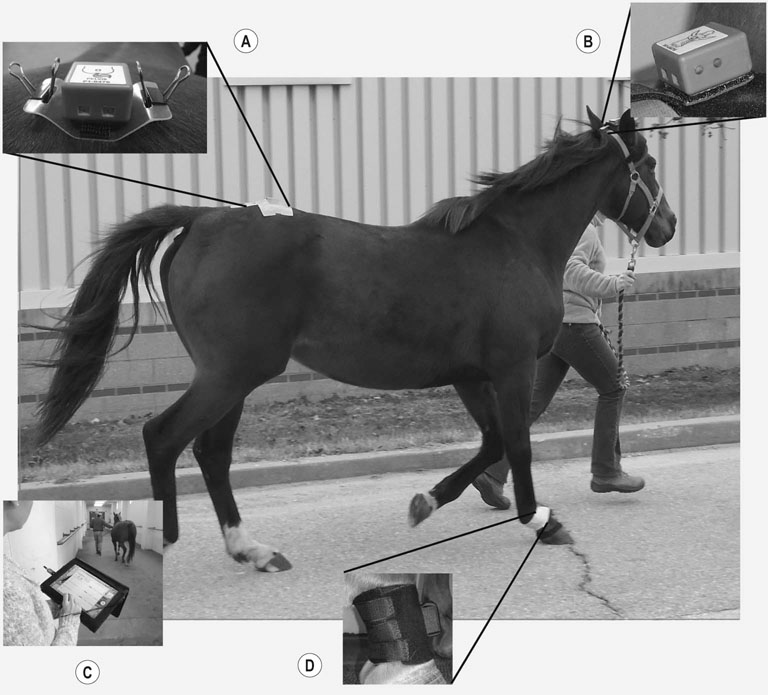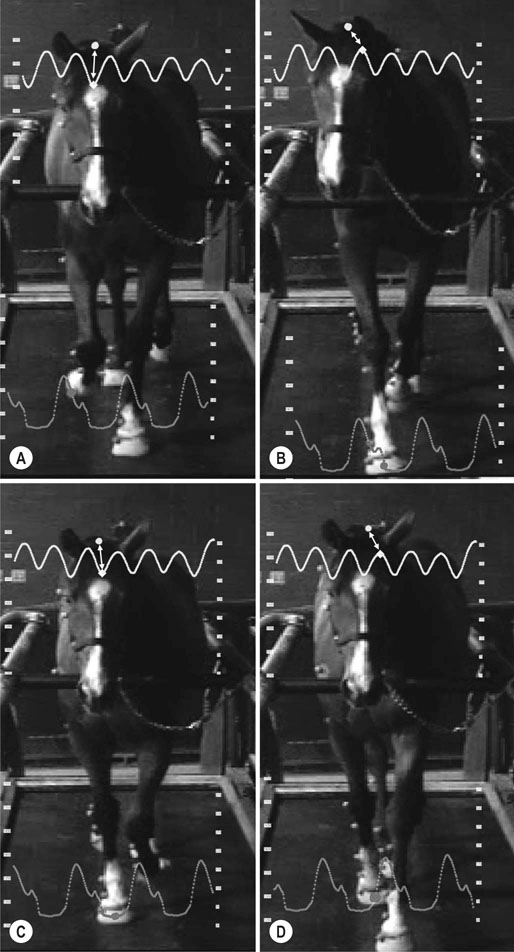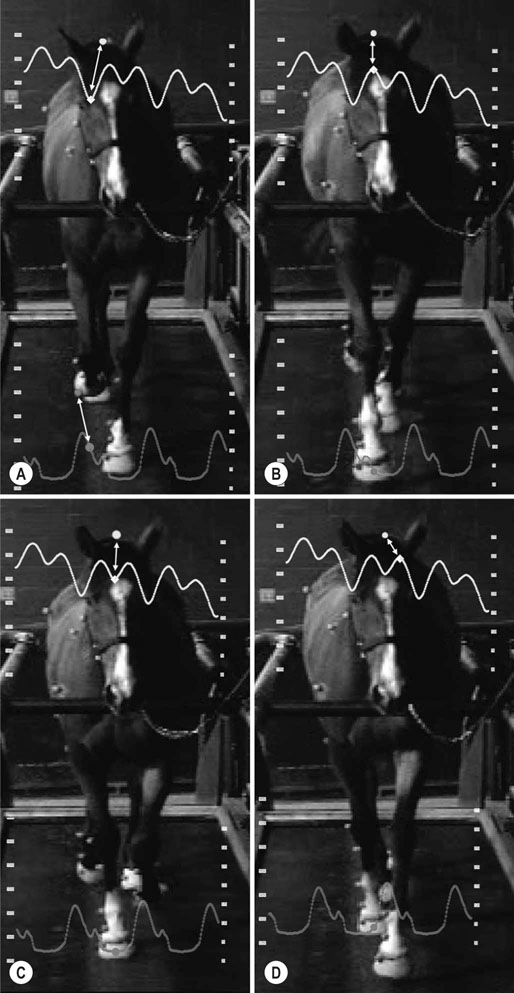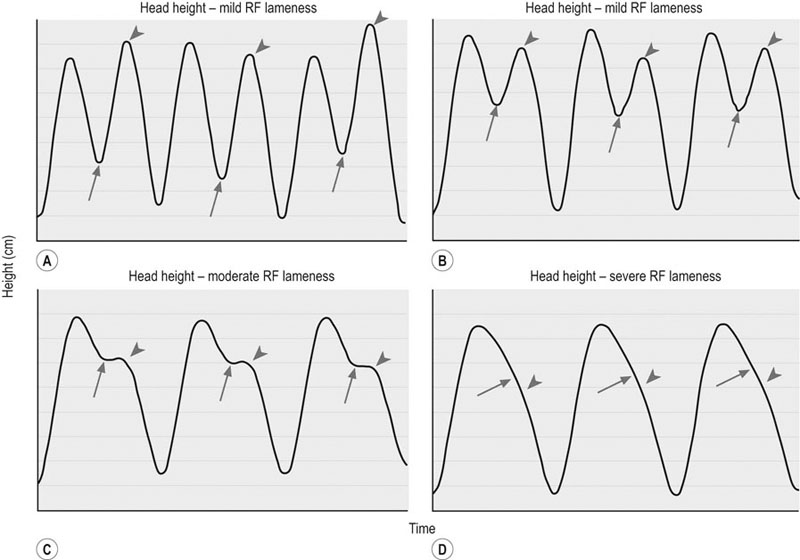It is not difficult to correctly detect and identify the affected limb in a lameness of moderate to severe intensity. There is little disagreement among equine clinicians and the diversity in our training poses little difficulty in these cases. However, when examining horses with intermittent lameness, lameness of mild intensity, or shifting-limb lameness, the diversity in our lameness training results in confusion, disagreement and, ultimately, disparate diagnoses. Even between skilled equine clinicians, inter-individual agreement for recognition of mild to moderate lameness and the designation of the correct lame limb have been shown to be poor or only marginally acceptable.1–4 The success of treatments for various lameness conditions has traditionally been based on subjective evaluations, imprecise lameness scores computed by few individuals or broad classifications of recovery such as return to function. These evaluative techniques are all potentially influenced by numerous factors unrelated to lameness severity. It has also been demonstrated that evaluators can be biased towards judging improvement in lameness after diagnostic analgesia.5 A more objective methodology to detect and quantify lameness would make lameness evaluations more scientific and thus more reliable. Additionally, objective methods may detect lameness earlier than subjective evaluation.6,7 Although movement compensation occurs with lameness during many gaits, the ideal gait for kinematic evaluation is the trot. The trot is a symmetrical gait with simultaneous contralateral forelimb and hindlimb placement in each half-cycle of the full stride. Vertical movement of the body is sinusoidal with equivalent amplitudes in each half-cycle. One of the most characteristic features of lameness is its tendency to upset the simple periodicity of normal movement. This perturbation of movement is most easily appreciated at the trot against the normal background of symmetrical vertical movement. In addition, the total vertical movement of the trunk’s center of gravity, and thus the resulting forces placed on the limbs during weight bearing, is greater during the trot than at a walk or canter.8,9 Lameness exacerbated by weight bearing, which includes the majority of lameness in the horse, may therefore be more expressed at the trot than at a walk or canter. In this chapter the kinematic changes referred to as representative of lameness are those primarily observed and measured at the trot. The kinematic method used most frequently to study how a horse moves in response to lameness is to mark the horse in some way at important body positions and to capture the movement of these markers with high speed cameras. Recently, movement in response to lameness can be captured wirelessly with small inertial sensors attached to the horse’s body.10–13 Both methods take advantage of being able to capture movement at higher sampling rates than the human eye, which is only about 15–20 samples per second.14 Thus, small changes in movement due to lameness that occur within millisecond durations can be reliably identified and recorded. By contrast, when inertial sensors are used to capture the movement, the area in which the movement is to occur is limited only by the range of wireless transmission of data, which, depending on the unique combination of radio and battery technology used, can be quite long. The main advantage of inertial sensor systems over camera-based kinematics is the ability to collect data from multiple, contiguous strides from horses moving naturally overground. However, in comparison to camera-based kinematics, less movement information can be captured and transmitted. Increasing the number of sensors, the sampling rate of the sensors, and the analog to digital conversion rate (required for radio transmission) strains the radio’s band width capability and battery size requirements. The ultimate size and weight of the body-mounted sensor is determined primarily by the radio and battery. Large, heavy sensors may influence movement. Without data logging, which is inconvenient for clinical use because data is not transmitted in real time, small sensors of low weight can only capture and transmit limited data in real time. The raw data from inertial sensors (acceleration, angular velocity) must also be converted to position and angle measurements in order to track trajectories of movement similar to camera-based systems. This conversion process is not error free and sophisticated error correction procedures must be implemented. Because of these limitations, kinematic systems utilizing inertial sensors are designed to sample movement from few locations on the horse’s body. They are more useful for quantifying movement with known association to a specific intent, for example lameness, rather than as a general investigative tool into the biomechanics of movement in horses. There are commercially available body-mounted inertial sensors systems (such as the Lameness Locator®, Equinosis LLC, Columbia, MO 65211 and the Equimetrix®, Centaure-Metrix, Evry, France) designed specifically as an aid to standard, expert veterinary evaluation of lameness in horses (Fig. 12.1). It is not the purpose of this chapter to exhaustively explain all the kinematic parameters of interest that have been studied, or that may be used by practitioners when visually assessing lameness. Much of what has been described in textbooks is subjective expert opinion. Text descriptions of how to visually identify lameness have at times conflicted with each other or have not been adequately described to allow for comparison. One only has to try to define and then reconcile the term ‘hip hike’ or ‘pelvic hike’, a frequent descriptor of hindlimb lameness in horses15–17 with pelvic ‘sinking’ or excessive rotation towards the side of lameness that is described in other reports.18,19 Some clinicians evaluate the ‘head bob or nod’ as greater upward movement of the head during the stance phase of the lame limb15–17 and others evaluate it as less downward movement during the stance phase of the lame limb.20 Some evaluate stride length and detect lameness when the length of stride or the caudal or cranial phase of the stride seems to be shortened or lengthened.16,17 The shape of the hoof flight arc is said to be representative of lameness.16 Joint angle excursions, during both the stance and swing phase of the stride, have been purported to be accurate indicators of lameness.19–21 Objective evaluations have indicated that some of the parameters described above are either incorrect or insensitive.22–25 In other cases when objective measurements of lameness are made we suspect that many clinicians are seeing the same alteration in movement but describing it differently. Movement of the limbs or changes in joint angles within the limbs, which may be specific for certain types or causes of lameness, displays either high side-to-side variability or is difficult to ‘see’ from multiple vantage points. For completeness, descriptions of limb movement parameters that have objectively been shown to be sensitive indicators of lameness are summarized in Table 12.1. We leave it to the reader to decide whether these parameters are useful in detecting lameness in a standard clinical examination. Table 12.1 Kinematic parameters of limb movement with known association to lameness In this chapter we have concentrated on describing head and pelvic motion as it relates to lameness in the horse. These are the generally-accepted and frequently-used motion parameters used by researchers and practitioners worldwide to evaluate lameness in horses. There is evidence to suggest that vertical movement of the torso, including the head, neck and pelvis, is the most sensitive indicator of lameness in horses.18,25–30 All of the information necessary to detect lameness and identify it to the correct limb can be found in evaluation of vertical head and pelvic movement. In the authors’ opinion, vertical head position is the most applicable and accurate movement parameter for use in clinical examination of forelimb lameness. It can be evaluated equally from the front or side of the horse. It is frequently exacerbated and made more apparent at the beginning (when the horse is accelerating) and end (when the horse is decelerating) of a short trot and when lunging the horse in short circles. However, conditions sometimes arise that make evaluation using this parameter more difficult. The asymmetrical nature of vertical head movement in some mild lameness conditions may not occur at every stride. As the intermittent nature of the lameness increases, the need to evaluate increasing numbers of strides becomes more important and the ability to detect overall asymmetric head movement becomes more difficult. In addition, extraneous head movement, especially in the curious or excitable horse in an unfamiliar environment, may obscure small perturbations in vertical head movement. It is especially important not to jump to conclusions after a few strides and instead try to determine the overall predominant head movement pattern before committing oneself to a final decision. Algorithms to remove extraneous vertical head movement have been described and can be used in objective analysis of vertical head movement to increase accuracy in detection of lameness.27 Thus, the head moves up and down in a sinusoidal, temporally symmetrical pattern, with amplitude equivalent cycles corresponding to each half of the full stride cycle (Fig. 12.2). The familiar ‘head nod’, as an indicator of forelimb lameness in horses, is a disruption of this symmetrical movement. In most weight-bearing lameness conditions, the downward head movement during weight bearing of the painful limb is reduced compared to that in the sound limb (Fig. 12.3). With increasing severity of lameness, there is more reduction in the downward movement of the head (Fig. 12.4). With severe lameness, there may be no downward movement of the head during the stance phase of the lame limb and with very severe lameness the head may actually move upward during the stance phase of the lame limb. For purposes of categorization, we have labeled lameness manifest by less downward movement of the head in the stance phase of the lame limb as impact lameness. Frequently in horses with impact lameness there is also more upward movement of the head immediately preceding lame limb stance, such that the head may actually still be moving upward at the moment of lame limb impact. This effectively reduces vertical force on the lame limb during the first half of stance. Consequently, with impact lameness, there is comparatively less upward movement of the head at the end of stance phase of the lame limb (Fig. 12.4
Kinematics of lameness
Introduction
Methodology

Kinematic parameters of importance for the detection of lameness
PARAMETER
DESCRIPTION
INCREASE OR DECREASE WITH LAMENESS
Maximum fetlock joint extension
Palmar/planter angle of fetlock at midstance
Decreases20,22–24,47–50
Maximum coffin joint flexion
Dorsal angle of coffin joint at midstance
Decreases20,22–24,49,50
Maximum carpal joint extension
Palmar angle of carpus during midstance
Decreases20,48,51
Stance phase duration
Duration between lame hoof impact and breakover
Increases20,23,47,52–54
Hindlimb protraction
The extent to which the hindlimb swings forward before impact
Decreases22,24
Kinematic evaluation of vertical head movement to detect and differentiate forelimb lameness



![]()
Stay updated, free articles. Join our Telegram channel

Full access? Get Clinical Tree


Veterian Key
Fastest Veterinary Medicine Insight Engine
